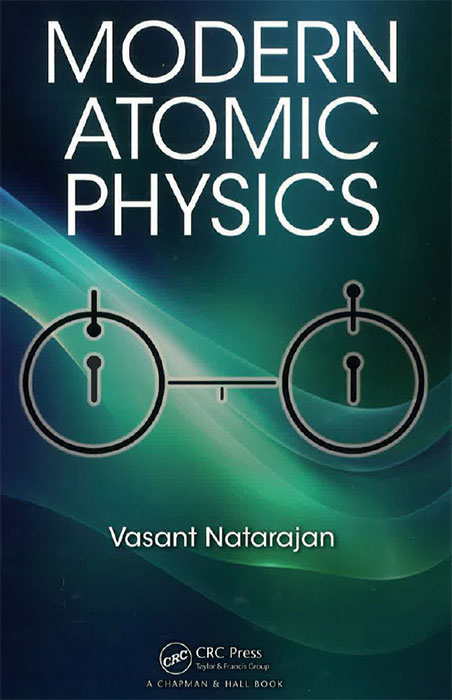By Vasant Natarajan
CRC Press

This book collates information from various literature to provide students with a unified guide to contemporary developments in atomic physics. In just 400 pages it largely succeeds in achieving this aim.
The author is a professor of physics at the Indian Institute of Science in Bangalore. His research focuses on laser cooling and trapping of atoms, quantum optics, optical tweezers, quantum computation in ion traps, and tests of time-reversal symmetry using laser-cooled atoms. He received a PhD from the Massachusetts Institute of Technology under the supervision of David Pritchard, a leader in modern atomic physics and a mentor of two researchers – Eric Cornell and Wolfgang Ketterle – who went on to become Nobel laureates.
The book addresses the basis of atomic physics and state-of-the-art topics. It explains material clearly, although the arrangement of information is quite different to classical atomic-physics textbooks. This is clearly motivated by the importance of certain topics in modern quantum-optics theory and experiments. The physics content is often accompanied by the history behind concepts and by explanations of why things are named the way they are. Historical notes and personal anecdotes give the book a very appealing flair.
Chapter one covers different measurement systems and their merits, followed by universal units and fundamental constants, with a detailed explanation of which constants are truly fundamental. The next chapter is devoted to preliminary materials, starting with the harmonic oscillator and moving to concepts – namely coherent and squeezed states – that are important in quantum optics but not explicitly covered in some other books in the field. The chapter ends with a section on radiation, even including a description of the Casimir effect.
Chapter three is called Atoms. Alongside classical content such as energy levels of one-electron atoms, interactions with magnetic and electric fields, and atoms in oscillating fields, this chapter explains dressed atoms and also, unfortunately only briefly, includes a description of the permanent atomic electric dipole moment (EDM).
The following chapter is devoted to nuclear effects, the isotope shift and hyperfine structure. At this point it would have been nice to see some mention of the flourishing field of laser spectroscopy of radioactive nuclei, which exploits the two above effects to investigate the ground-state properties of nuclei far from the valley of stability.
Chapter five is about resonance, which is often scattered around in other books about atomic physics. Here, interestingly, nuclear magnetic resonance (NMR) plays a central role, and the chapter connects this topic very naturally to atomic physics. The chapter closes with a description of the density matrix formalism. After this comes a chapter devoted to interactions, including the electric dipole approximation, selection rules, transition rates and spontaneous emission. The last section is concerned with differences in saturation intensities by broadband and monochromatic radiation.
Multiphoton interactions are the topic of chapter seven, which is clearly motivated by their importance in modern quantum-optics laboratories. Two-photon absorption and de-excitation, Raman processes and the dressed atom description are all explained. Another crucial concept in modern quantum optics is coherence. Thus it is included as a full chapter, which includes coherence in a single atom and in ensembles of atoms, as well as coherent control in multilevel atoms. Spin echo appears as well, showing again how close the topics presented in the book are to NMR.
Chapter nine is devoted to lineshapes, which is clearly a subject relevant for modern atomic spectroscopists. Spectroscopy is the next chapter, which starts with alkali atoms – used extensively in laser cooling and Bose–Einstein condensates. The rest of the material is aimed at experimentalists. Uniquely for such a book, it includes a description of the key experimental tools, followed by Doppler-free techniques and nonlinear magneto-optic rotation.
The last chapter covers cooling and trapping, with so many relevant concepts already presented in the preceding chapters. The content includes different cooling approaches, principles of atom and ion traps, the cryptic and equally common Zeeman slower, and even more intriguing optical tweezers.
Each chapter ends with a problems section, in which the problems are often relevant to a real quantum-optics lab, for example concerning quantum defects, RF-induced magnetic transitions, Raman scattering cross-sections, quantum beats or the Voigt line profile. The problems are worked out in detail, allowing readers to follow how to arrive at the solution.
The appendices cover the standards and the frequency comb, which is one of the ingenious devices to come from the laboratory of Nobel laureate Theodor Hänsch and which can be now found in an ever-growing number of laser-spectroscopy and quantum-optics labs. Two other appendices are very different: they have a philosophical flair and deal with the nature of the photon and with Einstein as nature’s detective.
The presented theoretical basis leads to state-of-the art experiments, especially related to ion and atom cooling and to Bose–Einstein condensates. The selection of topics is thus clearly tailored for experimentalists working in a quantum optics lab. One small criticism is that it would be good to read more about the EDM experiments and laser spectroscopy of radioactive ions, which are currently two very active fields. Readers interested in different classic subjects, like atomic collisions, should turn to other books such as Bransden and Joachain’s Physics of Atoms and Molecules.
The level of the book makes it suitable for undergraduate level, but also for new graduate students. It can also serve as a quick reference for researchers, especially concerning the topics of general interest: metrology, what is a photon or how a frequency comb works, and how to achieve a Bose–Einstein condensate. Overall, the book is a very good guide to the topics relevant in modern atomic physics and its style makes it quite unique and personal.







